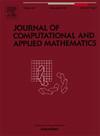基于pass的局部测量热方程逆源问题收敛性分析
IF 2.6
2区 数学
Q1 MATHEMATICS, APPLIED
Journal of Computational and Applied Mathematics
Pub Date : 2025-09-23
DOI:10.1016/j.cam.2025.117077
引用次数: 0
摘要
本文研究了从局部测量数据中恢复抛物系统源项空间分布的问题。我们提出了一种基于物理信息神经网络(PINNs)的方法来近似求解这一反问题。在这个框架内,我们设计了一个新的损失函数,它包含了偏微分方程(PDE)的残差、测量数据残差以及初始边界条件和边界导数的残差。这些附加项增强了解的正则性,以解决逆问题的病态性。基于反问题的条件稳定性,我们证明了神经网络可以有效地逼近其解,并进一步建立了依赖于训练误差和数据噪声水平的源项泛化误差估计,同时验证了网络的收敛性。一系列数值实验进一步验证了该方法的有效性和鲁棒性,表明该方法在噪声数据和不同测量条件下都能达到较高的精度和效率。本文章由计算机程序翻译,如有差异,请以英文原文为准。
Convergence analysis of a PINNs-based approach to the inverse source problem of the heat equation with local measurements
This paper investigates the problem of recovering the spatial distribution of the source term in a parabolic system from local measurement data. We propose a method based on Physics-Informed Neural Networks (PINNs) to approximate the solution of this inverse problem. Within this framework, we design a novel loss function that incorporates the residuals of the partial differential equation (PDE), measurement data residuals, as well as residuals from initial–boundary conditions and boundary derivatives. These additional terms enhance the regularity of the solution to address the ill-posedness of the inverse problem. Based on the conditional stability of the inverse problem, we demonstrate that the neural network can effectively approximate its solution, and we further establish generalization error estimates for the source term, which depend on the training error and data noise level, while also verifying the convergence of the network. A series of numerical experiments further validate the effectiveness and robustness of the proposed method, showing that it achieves high accuracy and efficiency under noisy data and varying measurement conditions.
求助全文
通过发布文献求助,成功后即可免费获取论文全文。
去求助
来源期刊
CiteScore
5.40
自引率
4.20%
发文量
437
审稿时长
3.0 months
期刊介绍:
The Journal of Computational and Applied Mathematics publishes original papers of high scientific value in all areas of computational and applied mathematics. The main interest of the Journal is in papers that describe and analyze new computational techniques for solving scientific or engineering problems. Also the improved analysis, including the effectiveness and applicability, of existing methods and algorithms is of importance. The computational efficiency (e.g. the convergence, stability, accuracy, ...) should be proved and illustrated by nontrivial numerical examples. Papers describing only variants of existing methods, without adding significant new computational properties are not of interest.
The audience consists of: applied mathematicians, numerical analysts, computational scientists and engineers.

 求助内容:
求助内容: 应助结果提醒方式:
应助结果提醒方式:


